The Parish Council sold part of the Tysoe village playing field to Warwickshire County Council for £1402, an equitable price for agricultural land at the time, on the understanding that the land must be used only for the construction of a new Fire Station. The total cost of the new station was £24,320, which included a drill yard and a steel tower.
The main contractors were a local company, R. Brisker & Sons Ltd., of Kineton, and construction was completed in November. The call out system was installed and used from 24 October 1972. The pump, and all the station equipment, were moved by the crew to the new Station on 3 November 1972.
The Karrier Pump 5178 AC was replaced with a Bedford TK Pump, registration SWD 999G. The wooden Ajax ladder was replaced at this time by an aluminium 10.5 metre ladder and the B.A. sets were located in the cab.
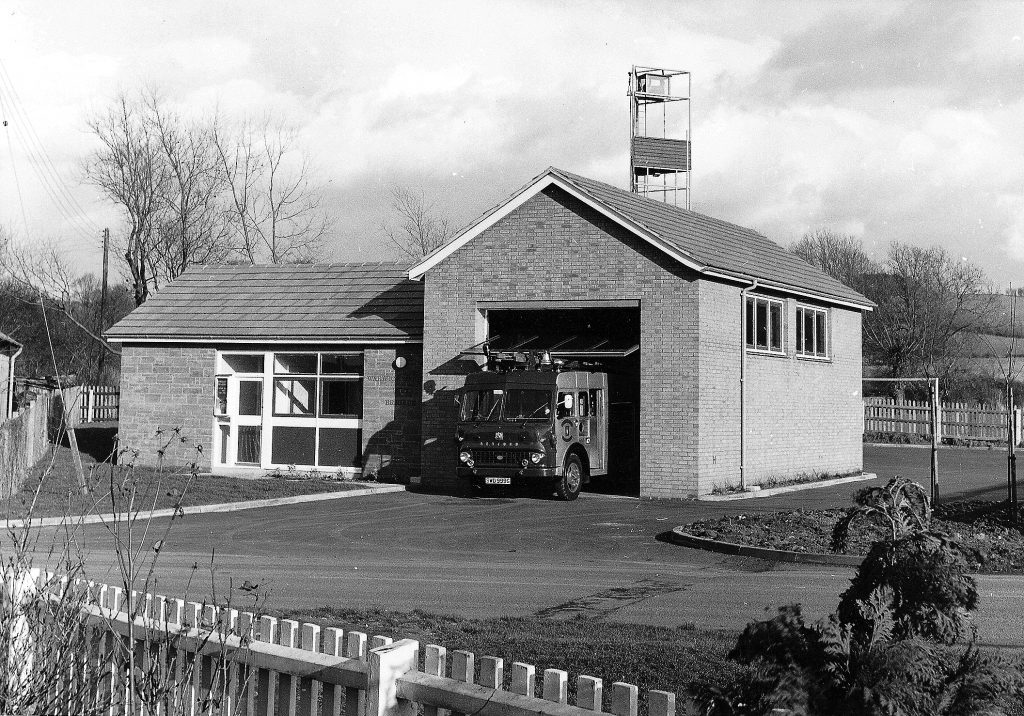
The siren was no longer used to call the firemen out. It was to be used only for the ten minute nuclear warning. The firemen were provided with personal ‘alerters’, which produced an intermittent bleeping tone for a fire call. At night the alerters were put into charging units, which had acoustic hoods on top to provide amplification.

1973
Forty-three calls were recorded during the year, including fourteen chimney fires, one Road Traffic Accident, nine false alarms, six fires in houses or buildings, eleven farm fires (five of which were in barns or grain dryers), one call to the scrapyard on the Hornton-Edgehill Rd, where some seventy-five cars were on fire and hose reels were used, and a call to a large fire at the factory of General Foods Ltd in Banbury. At this last call the crew was transferred by radio to stand-by duty at Banbury Fire Station to give cover to the town. This was the first incident of stand-by duty since the N.F.S. days in the Wartime.
Among the house fires, a wooden bungalow at Edgehill was burned to the ground in a fire at which two jets and six B.A. sets were used. For some time the owner was believed still to be inside the bungalow, but he was later found delivering coal on his round in another village.
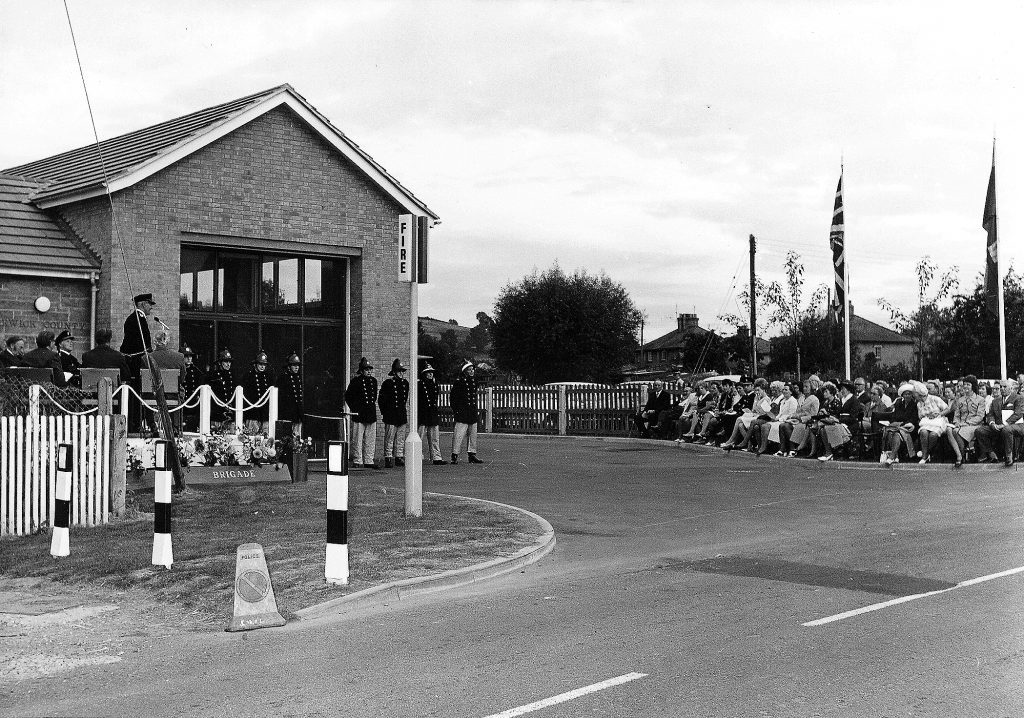
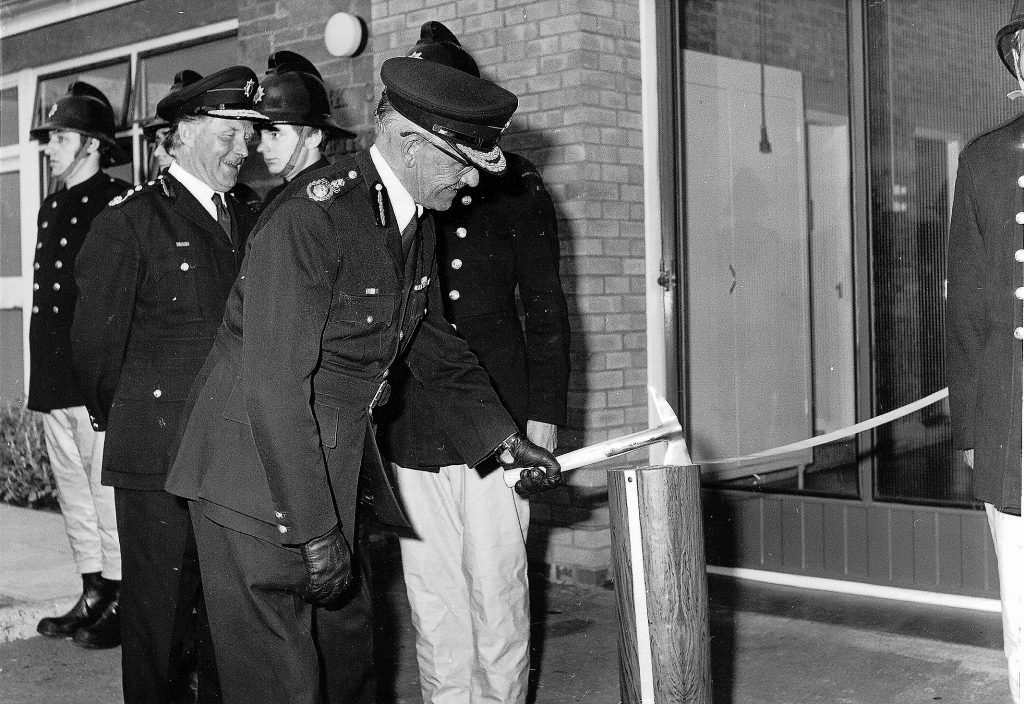
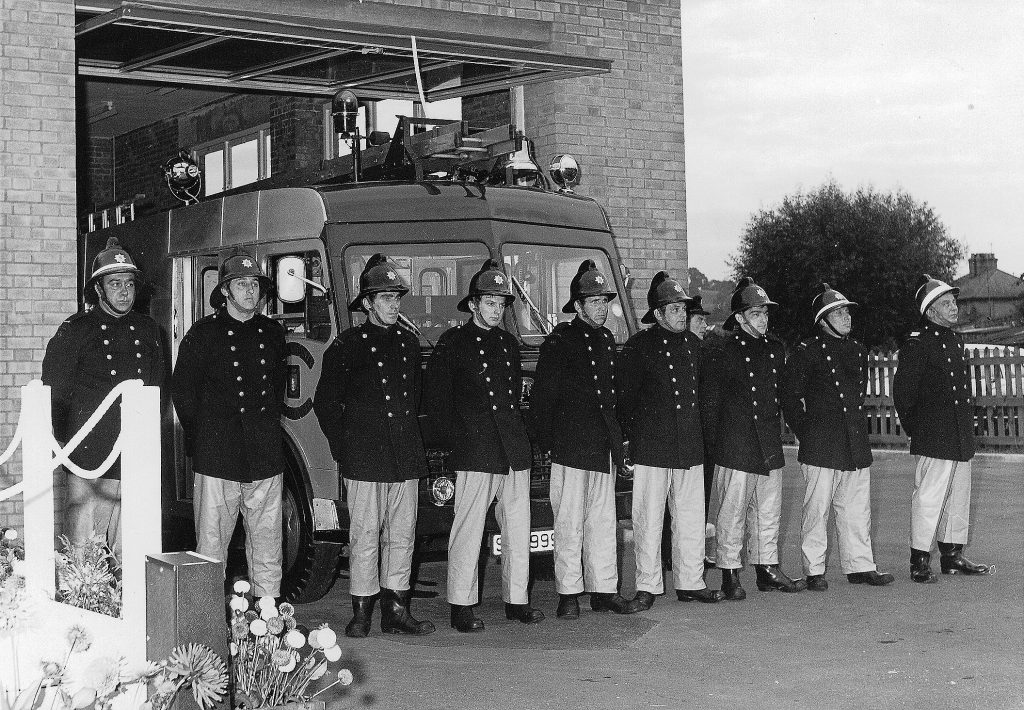
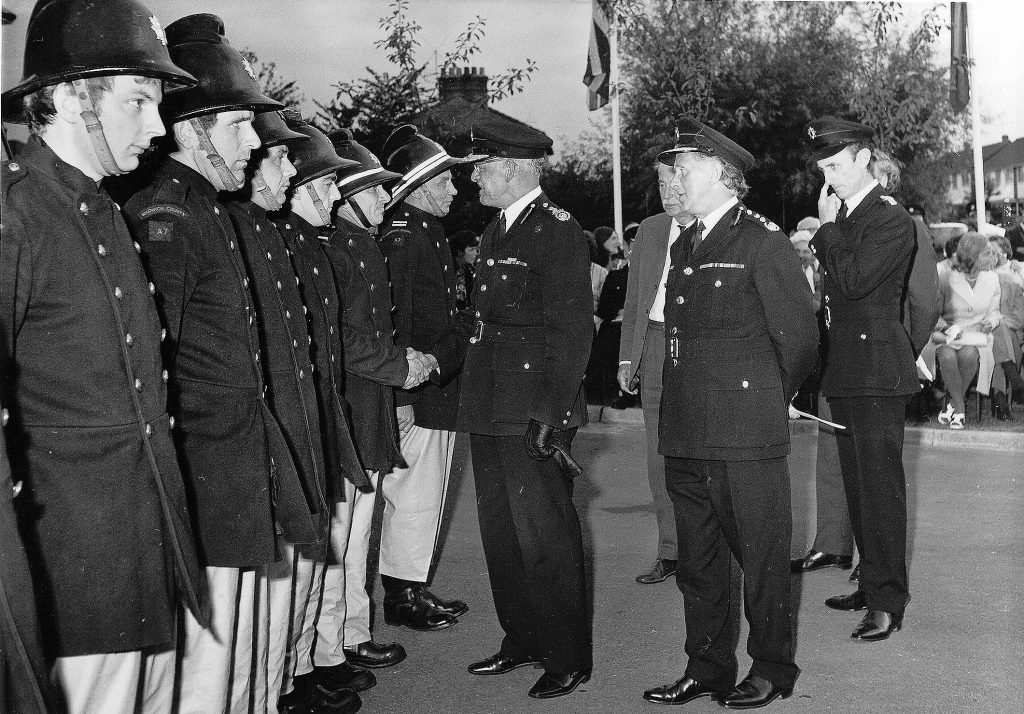
After the opening of the Station, guests were invited by the County Fire Officer to a display of fire-fighting by the Tysoe crew in the drill yard and up in the tower. The New Station proved to be a major improvement in training facilities, and indeed in public relations, since the old Station had no yard or tower, the crew being forced to use the road and car park at the village school for drill, with the side wall of the main school building acting as the tower.
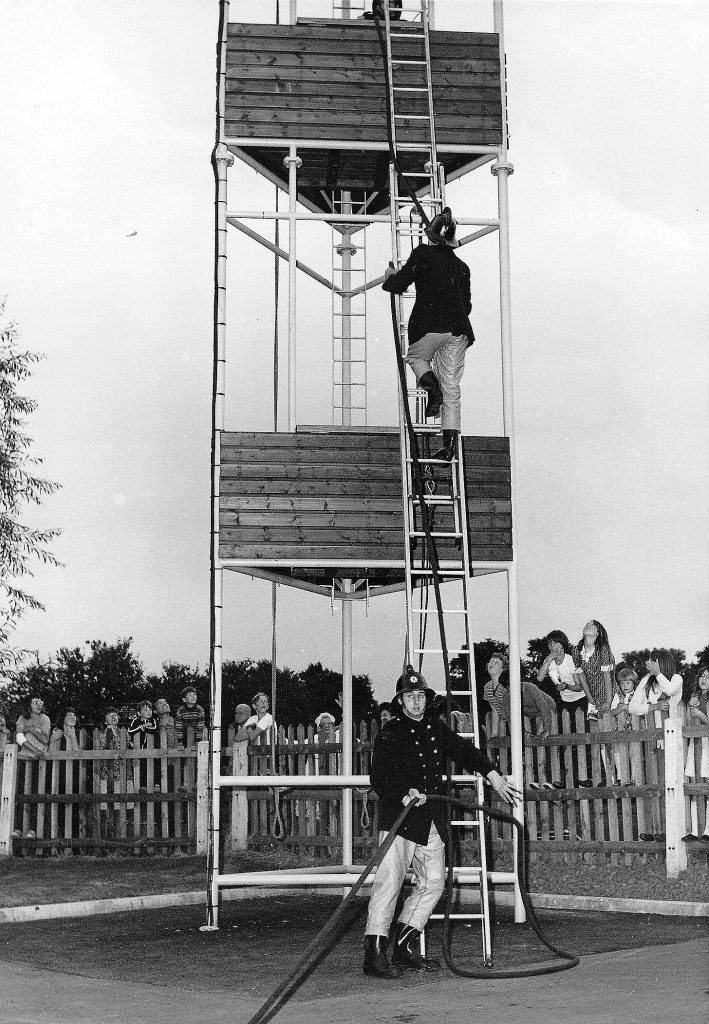
On Boxing Day at 13.26 the crew was called to Willington, where a flat felt roof was on fire. A hose reel was used, and the cause was found to be a chimney fire. The oven contained an extremely well cooked turkey.
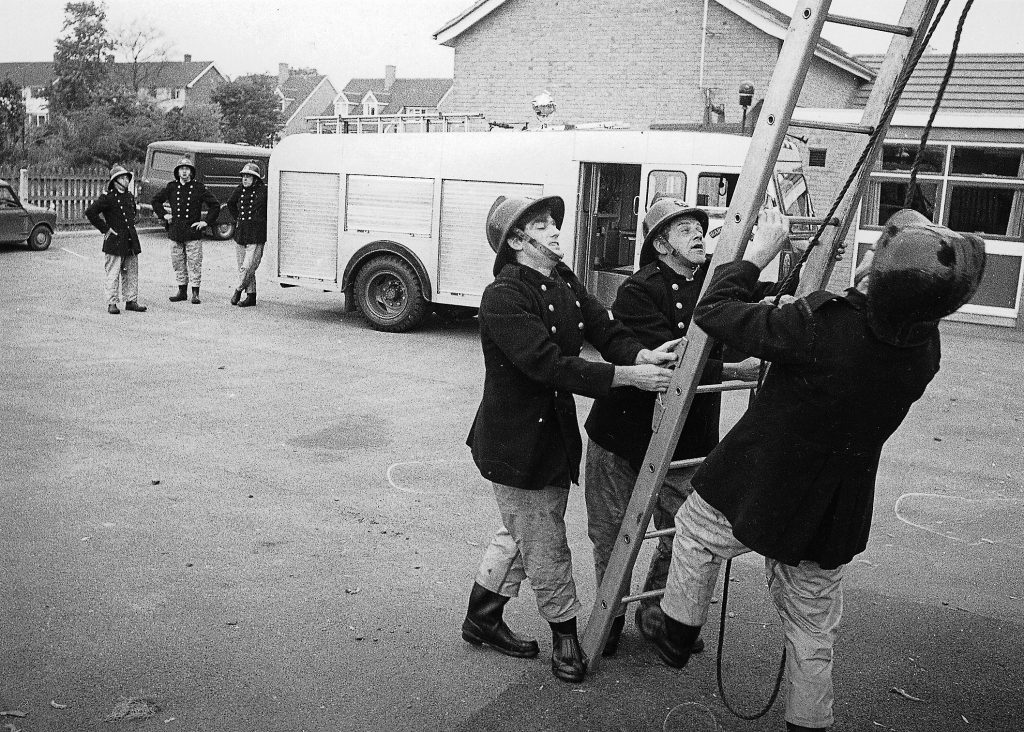
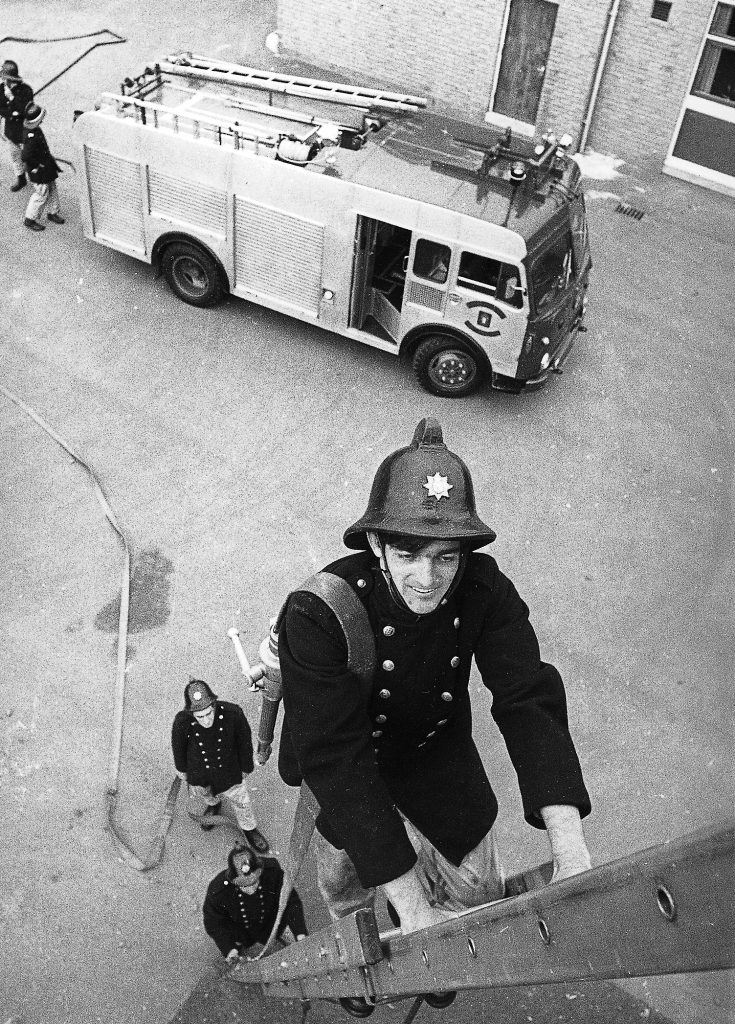
1974
There were thirty-two calls during the year, with six chimney fires, three false alarms, one vehicle fire, one tree fire, eight farm fires, four of which were in barns, and thirteen house and building fires.
One of these calls was to a fire in a thatched roof at Caylderwell farm cottages, Shipston on Stour, where two jets and hose reels were used. In April the station call number was changed from Alpha 7 to 5-8.
1975
Thirty-eight fire calls were recorded, including four chimney fires, four vehicle fires, two of which were lorry fires each requiring three jets, six false alarms, five farm fires, two of them barns, and nineteen house or building fires.
At the Police House in Tysoe, within a row of thatched cottages, the policeman had been called out, and had inadvertently left the chip pan on. It was fortunate that the Fire Station was in the village, because only the kitchen was burned out. Two hose-reels and B.A. sets were used.
It was in 1975 that the threat of closure of the Station first became apparent. Six stations, all on the periphery of Warwickshire, were nominated for closure. These were at Bidford-on-Avon, Brinklow, Fenny Compton, Polesworth, Studley and Tysoe. All were reprieved from closure by the Conservative controlled Council of the time, and a celebration party was held in the Station for all of the firemen. The committee and their families had organised actions to fight the threat of closure.
At the end of the year Sub Officer J Quinton retired and Leading Fireman E. Townsend was promoted to Sub Officer.
1976
This was a busy year, with seventy-eight calls recorded. These included a tree in the playing field, a call to the rubbish tip on Upton Estate, six false alarms, nine chimney fires, twenty-two house or building fires, thirty-one farm fires, three of which were in Dutch Barns, one call to a fire on the railway embankment at Bishops Itchington, and seven stand-by duties at Fire Stations at Kineton, Banbury, Leamington Spa, Stratford upon Avon and Nuneaton.
One of the more serious house fires was at 5 Church Lane, Whatcote where hose-reels and B.A. sets were used. Many of the other calls involved fires in grass, hedgerows and stubble fields, since 1976 was one of the hottest summers of the century. Some of the calls were of longer than usual duration, being to places such as Coleshill, Nuneaton, Kenilworth, Hatton etc, and included all-day duty at these fires.
Fireman K Wyles was promoted to Leading Fireman in January.
1977
Forty-four calls were logged in the year. These included a Road Traffic Accident on Sunrising Hill, a call to a petrol tanker which had overturned in the snow near Compton Wynyates, an oil spillage in Tysoe, a lorry fire, four false alarms, eight chimney fires, eight farm fires, including one Dutch Barn at Shipston on Stour, which required two relief crews from the Station, and twenty house or building fires, one of which was on Jubilee Day, 7 June 1977. This call was to Little Kineton, where a thatched roof was burning on the inside. The burning thatch suddenly collapsed on top of Leading Fireman Wyles and Fireman Billing, who were inside below the roof and some of the crew from Kineton who were outside.

The fire had been started by a spark from the Jubilee celebration bonfire on the village green.
On this Jubilee Day, the crew was on a lorry taking part in the village procession, which went from the School to Upper Tysoe and back to the playing field, dressed as The Wurzels, the ‘county bumpkins’ singing group. The members of the Kineton crew were dressed as Cavaliers. It must have been an extraordinary sight for the onlookers to see fire tunics being removed in order to shake out the burned thatch.
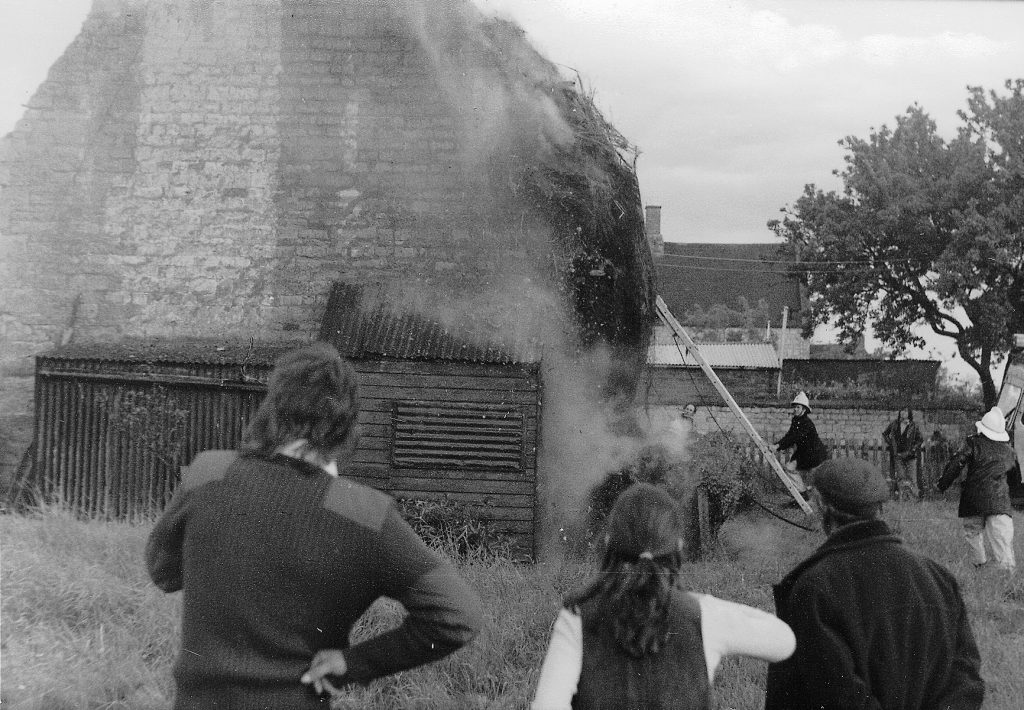
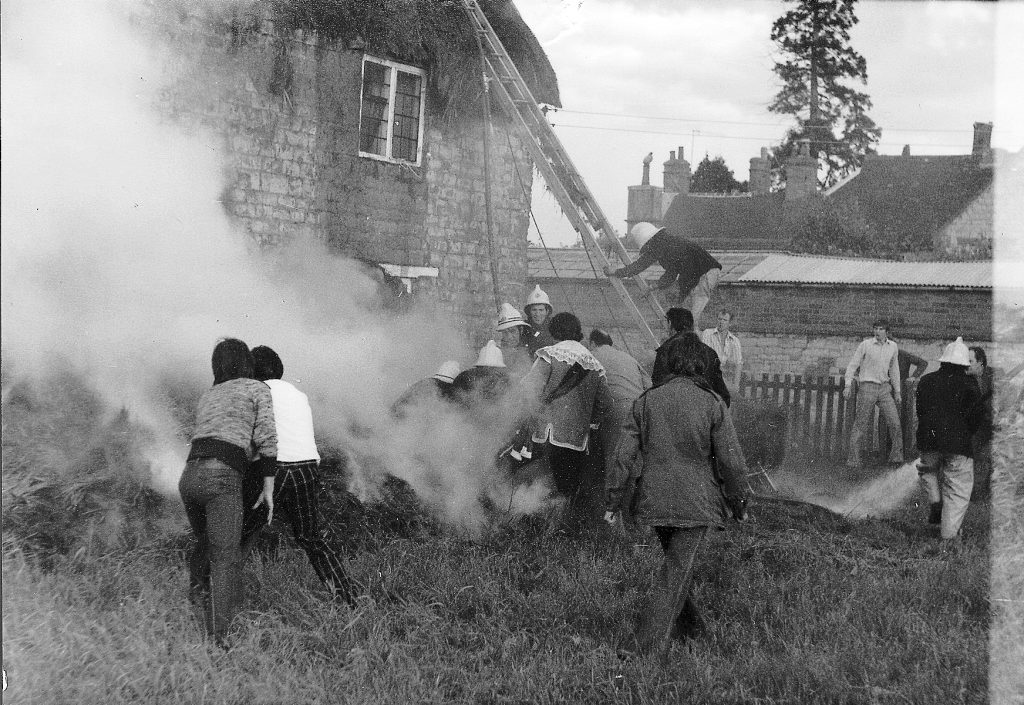
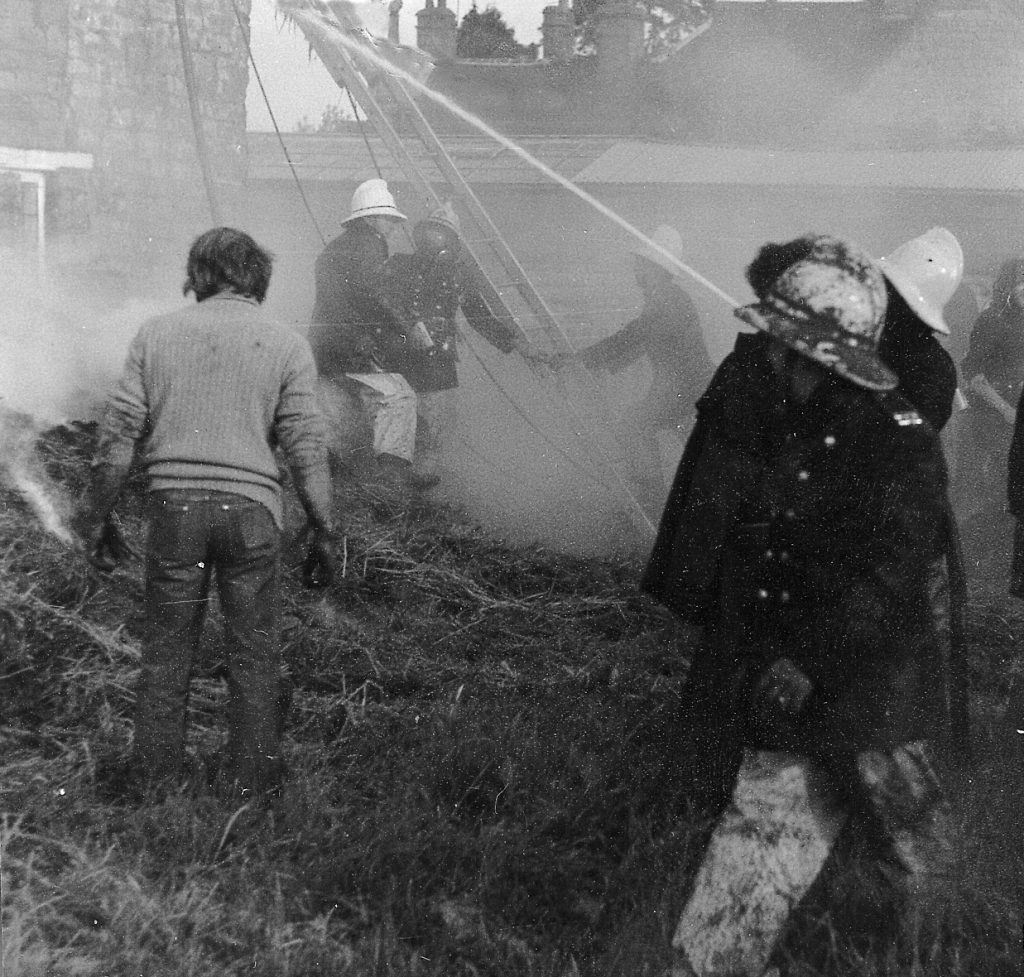
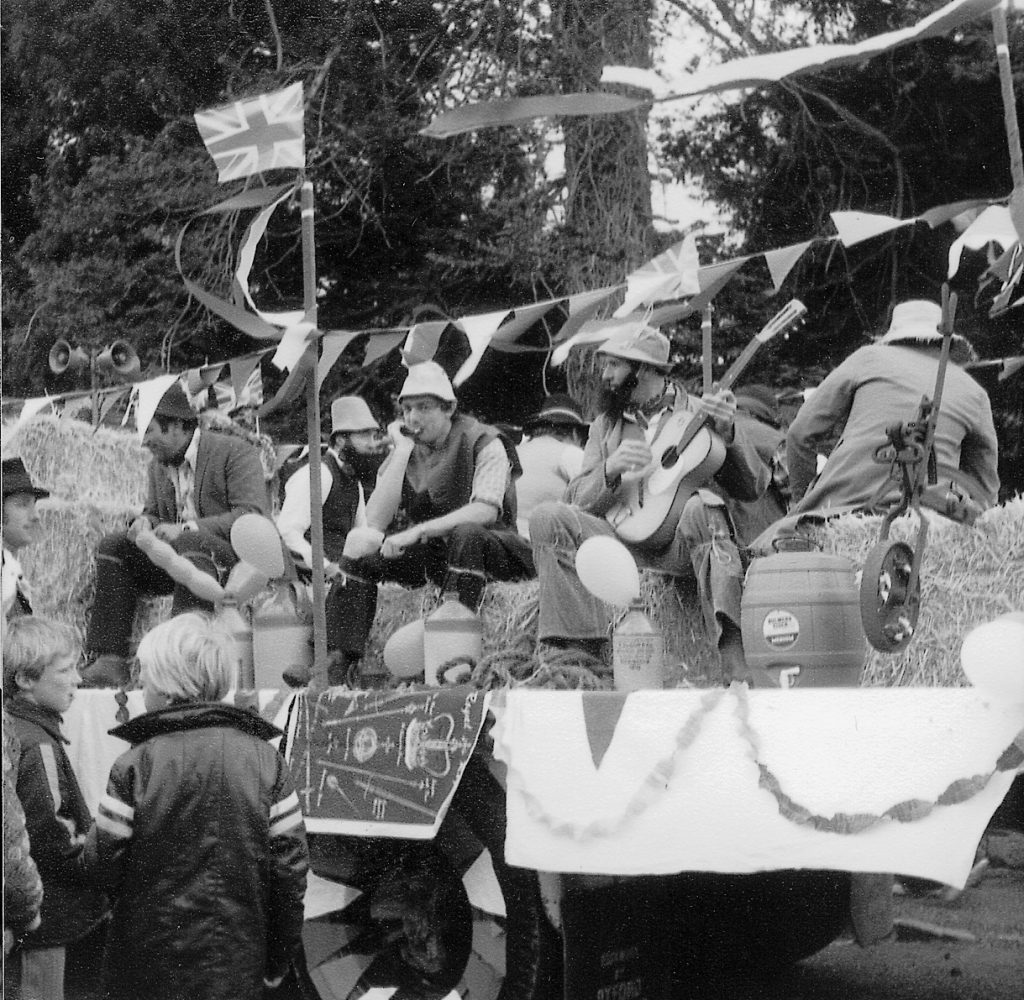
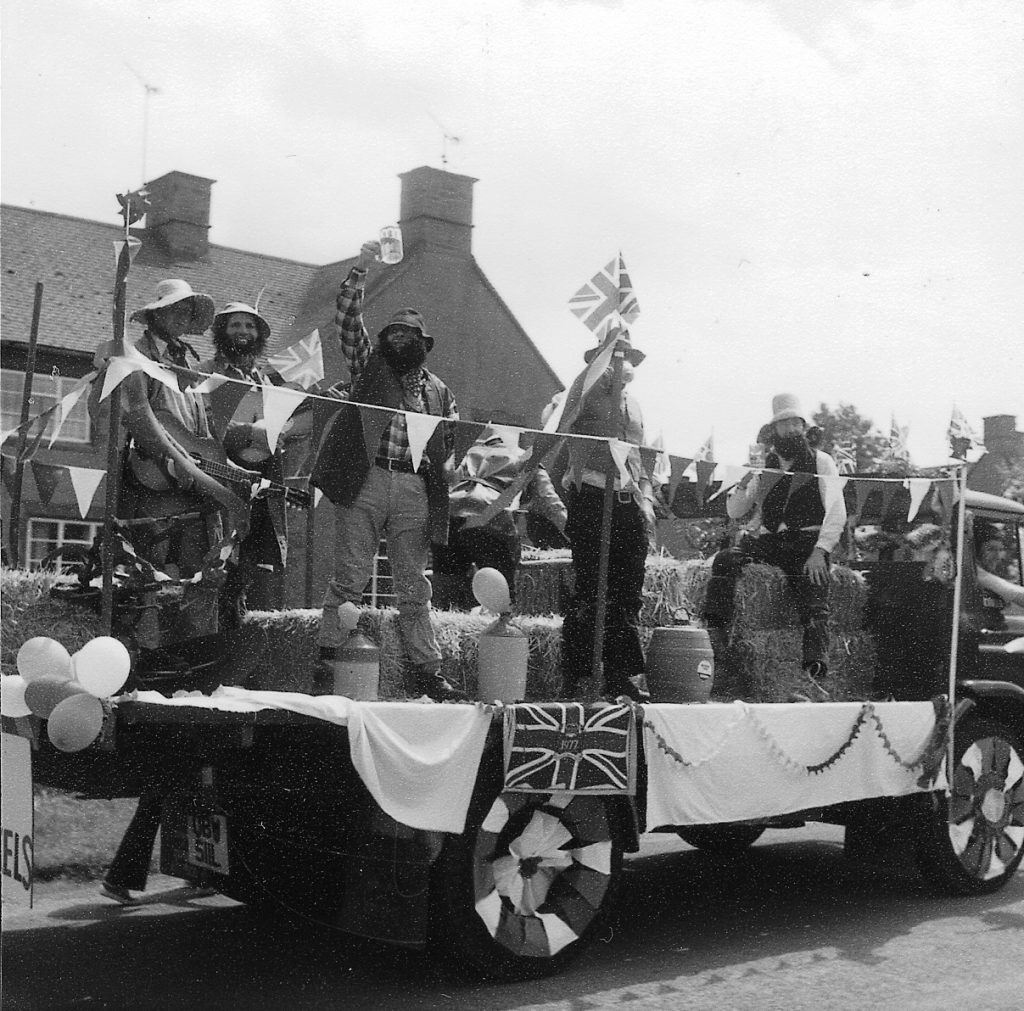
Most of the barrels on the lorry were full of cider at the start of the trip and were empty by the time the lorry reached the playing field.
Towards the end of the year, in spite of a national strike call by the Fire Brigade Union, a vote was held at the Station, as a result of which the crew decided to attend calls in the area. This was in recognition of the fact that all of the local villages had previously given their overwhelming support to the Station when it had been threatened with closure.
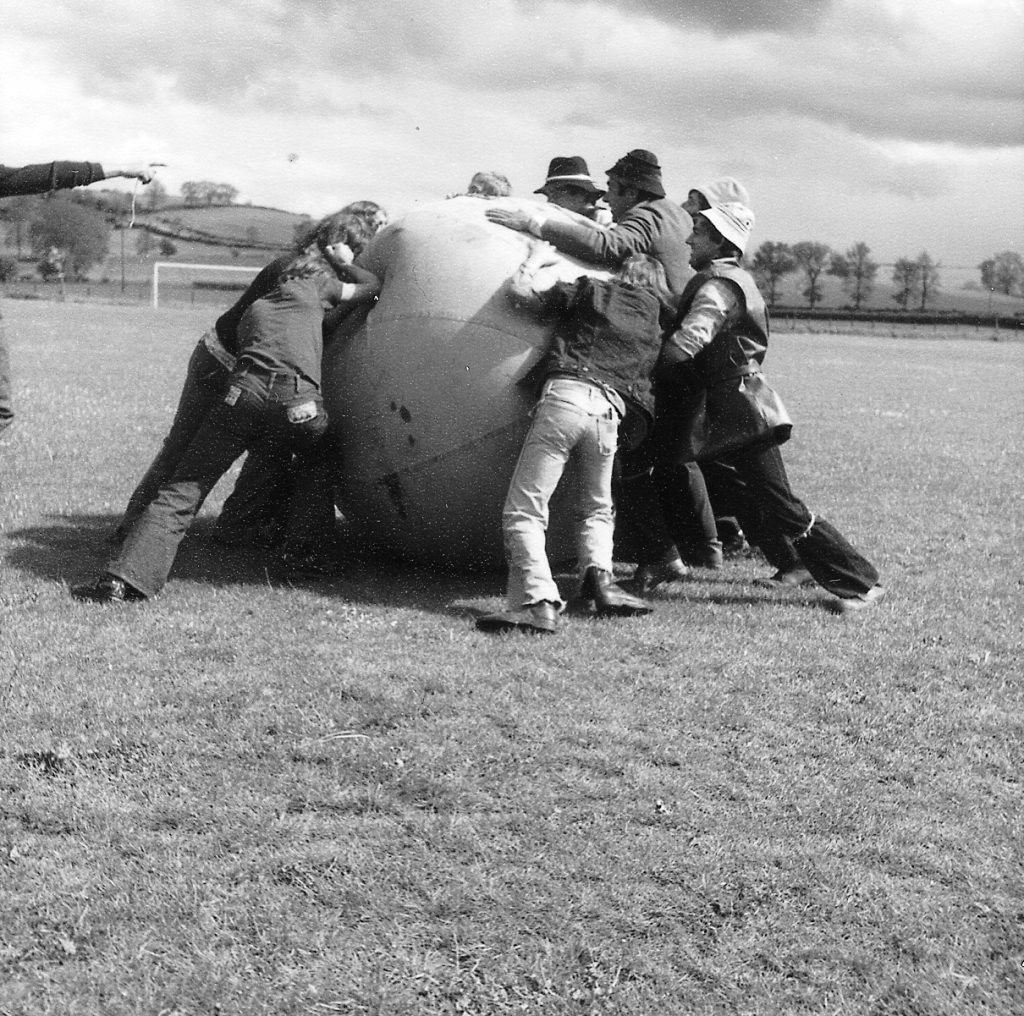
On the night of 22 November the crew was called to the Hilton Hotel at Stratford upon Avon, where guests were trapped in a bedroom fire. Two people were helped out into the fresh air by men wearing B.A. The Tysoe crew, with some full time officers, attended this fire. Since there was still an official strike on, full time men came out to picket the Station, but the feeling among the villagers was that if the Tysoe men were to be picketed, then the villagers themselves would also ‘picket’ the visiting full time firemen.

The personal alerters were replaced by smaller ones, containing batteries which did not require overnight charging.
1978
A total of fifty-four calls were recorded, including a caravan which was burned out at Butlers Marston, two tree fires, a motor cycle fire, two Road Traffic Accidents, a Trailer load of straw, nine chimney fires, ten false alarms, twelve farm fires, six of which were Dutch Barns, and sixteen fires in houses or buildings.
The motor cycle rider appears, whilst at the village filling station, to have allowed some petrol to overflow onto the engine, with the unfortunate result that the petrol ignited, causing the petrol tank to explode. He suffered burns to the tops of his legs and to his lower body, and was lowered into a bath of water in a house in Middleton Close until the ambulance arrived.
At one of the farm fires, in Ratley, three large pigs were killed, and two of the house fires involved properties with thatched roofs. One of these was at Burdrop, near Sibford Gower, and at the other, in Bell Street, Shenington, a grand piano was dismantled and removed in only three minutes. After being reconstructed outside, it was still playing and tuneful!
Fireman P Billing was presented, by Councillor J Brindley, with the Fire Brigade Long Service and Good Conduct Medal after 20 years’ service at the Station.
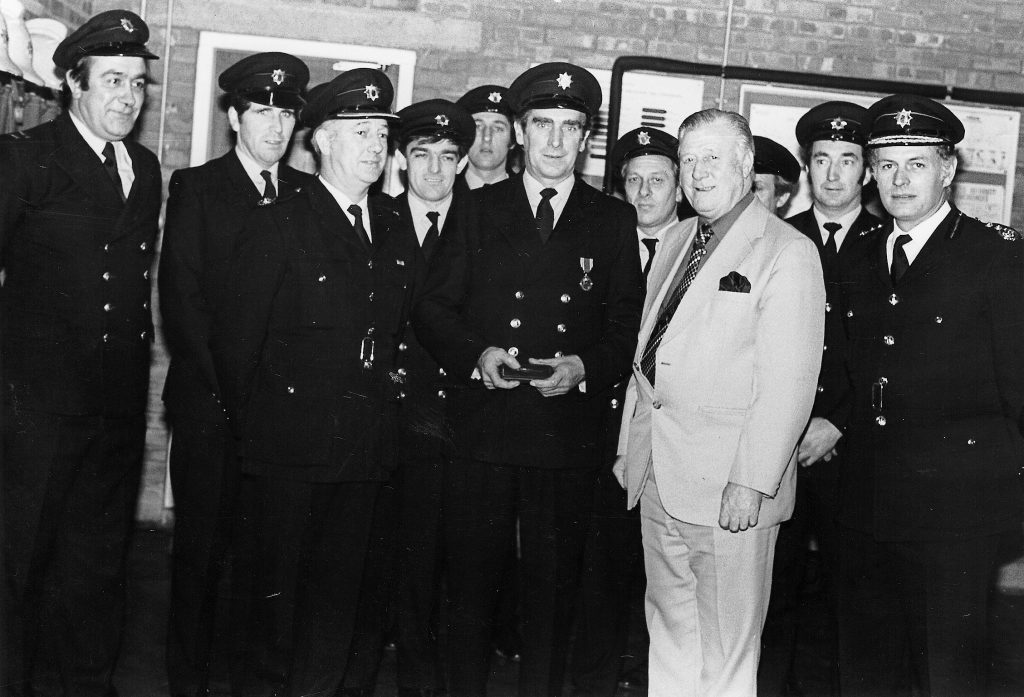
The Bedford TK was replaced with another TK Pump, registered VWD 999H.
1979
Seventy-seven calls were recorded, including one stand-by, two Road Traffic Accidents, two vehicle fires, one of which was a tanker, one call to Leamington Fire Station, where H M Inspector of Fire
Services had the crews on drill duties using all available equipment on the Pump, fourteen chimney fires, eleven farm and barn fires, twenty-one false alarms, nineteen house or building fires, and six calls to floods.
Most of the false alarms seem to have come from Shipston Engineering, Norton School, Little Kineton, and Wroxton College at Wroxton St Mary, near Banbury.
An unexpected turn of events occurred as burning thatch was being removed with drags from a row of cottages at Bloxham, when a member of the crew cut through a very large wasps’ nest, half of which rolled down and fell away from the roof. It seems the wasps were not best pleased by this treatment, and attacked the men. Those on the ladder reached the ground in record time, but it still took a powerful jet of water to restore peace to the scene.
The flood calls were all on 27 December, to Shipston on Stour, Little Compton, Long Compton and Tredington. At Tredington water was up to the top of a door, and as the door was opened a grandfather clock floated past.
The station call sign was changed for the last time to 33 (three-three).
Mr B King, a retired Leading Fireman, died in November and his dying wish, to be buried in his fire service uniform, was granted. Mr King showed the dedication which had been evident among all of the men since the Brigade was formed back in 1897.
1980
The year comprised a total of sixty-seven calls, including two Road Traffic Accidents, three vehicle fires, seven farm fires, three of which were barns, fifteen chimney fires, eighteen false alarms, and twenty-two house or building fires.
In a fire at Rolworths, High St, Shipston on Stour, two people were rescued from the roof. There was a serious fire at Ettington Park Hotel, and another at Cherington House, Cherington, a Home Farm Trust home for adults. In the Wykham Arms, at Sibford Gower, the thatched roof caught fire one afternoon, just a few hours before a new extension was to open, the roof being completely destroyed. On 5 November a rocket firework landed on a thatched roof at Upper Tysoe, but the crew saved all but an area of some 10ft by 8ft.
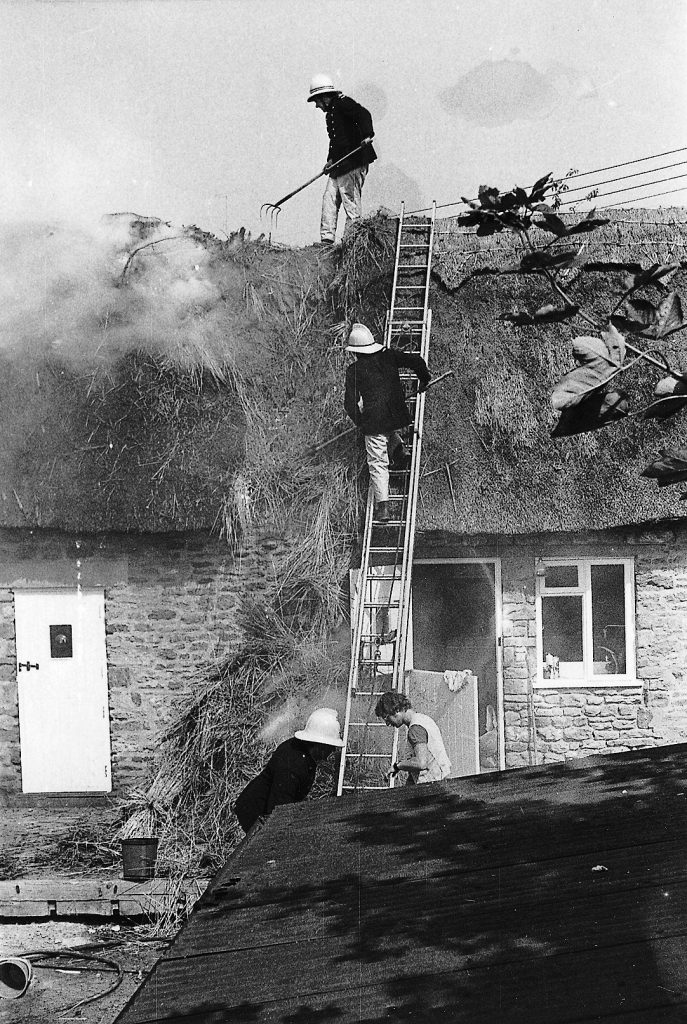

1981
Fifty-one calls were noted, with one tree fire, eight vehicle fires, which included six cars, one motor cycle and a dust cart at Alkerton Tip, seven farm fires, two of which were barns, eleven chimney fires, thirteen false alarms and eleven house or building fires. Twelve calves and twenty-five sheep were rescued from a farm fire at Whatcote.
The station was equipped with a set of decontamination suits.
The Bedford TK was replaced by another Bedford Pump, registered ANX 999J
1982
Forty-seven calls were recorded, including one Road Traffic Accident, an exercise at C.A.D. Kineton for H M Army Inspector, a call to an oil spill on the Knowle Hill at Edgehill, a call to the National Film Archives Storage Unit, four vehicle fires, five farm fires, one in a barn, seven chimney fires, twelve false alarms and fifteen house or building fires, two of which involved chemicals and one a thatched roof.
Sub Officer Townsend resigned in August and Leading Fireman Wyles was promoted to Sub Officer.
The station was now equipped with rescue equipment, which included a Cengar Reciprocating Saw, Zip Gun, Epco, and air pack, which made rescues at Road Traffic Accidents a great deal easier.
The alerters were again replaced with smaller ones.
The Bedford was replaced by a Bedford with a Jaguar engine (known as a Bedford Jag.) registered ONX 999M, and a second set of decontamination suits was issued to the Station.
1983
Seventy-seven calls were recorded, including two stand-by calls, two Road Traffic Accidents, six vehicle fires, eleven farm fires, four of which were in barns, fourteen house or building fires, fifteen chimney fires, and twenty-seven false alarms.
One of the fires was at Compton Wynyates house, where two B.A. sets and a hose-reel were used.
Fireman J Brain was promoted to Leading Fireman in January and Fireman K Oliver to Leading Fireman in December.
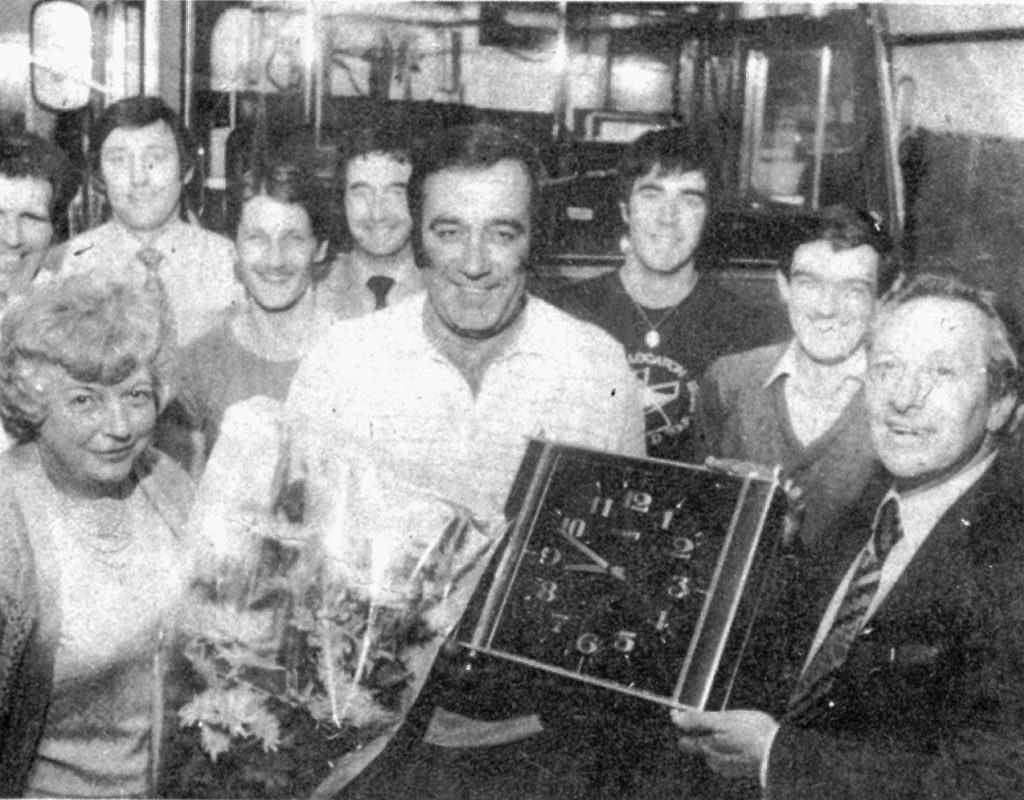
This was the last year of the Warwick County Fire Brigade, Tysoe Challenge Cup, six-a-side inter-village football competition. It was organised by the firemen from 1968 until 1983, and was held annually in the playing field at the village flower show. Up to one hundred and twenty teams played in the competition, coming from an area from Birmingham to Oxford. The organisation of all teams and referees was undertaken by Fireman K Oliver and proceeds were donated to the Fire Service Benevolent Fund and to various good causes of the village.
1984
Eighty-three calls were logged, including one refuse tip fire, a caravan fire, two tree fires, two stand-by calls, three Road Traffic Accidents, three special service calls to wash away petrol from roads and to attend to a gas leak in Shipston on Stour, five false alarms, eleven vehicle fires, thirteen farm fires, fifteen chimney fires and twenty-seven house or building fires.
Most of the farm fires involved standing corn or hedgerows, although wo were in barns. On a farm at Warmington a poultry battery house burned out and all 2500 hens were killed. In another wooden battery house just a few feet away all the hens were saved.
In a fire at Harrods Farm, Whatcote, flames eight feet high were coming from the four-foot chimney pots, and the effect was that of huge Bunsen burners. The farmer thought that the last time the chimney had been swept was about 35 years earlier. Leading Fireman Oliver used a garden hoe inside the chimney to remove the burning soot whilst the rest of the crew applied water from both the top and bottom of the chimney. No water came out into the room.
A tree fire in Whichford Wood required three pumps and seventy lengths of hose to reach it.
The most serious fire of the year was at the McGregory Cory warehouse in Banbury, where ten pumps with twelve jets and twenty B.A. sets were needed to get the fire under control. There was also a serious fire at Tadmarton House, which required a hose relay of forty-eight lengths from the hydrant to the building.
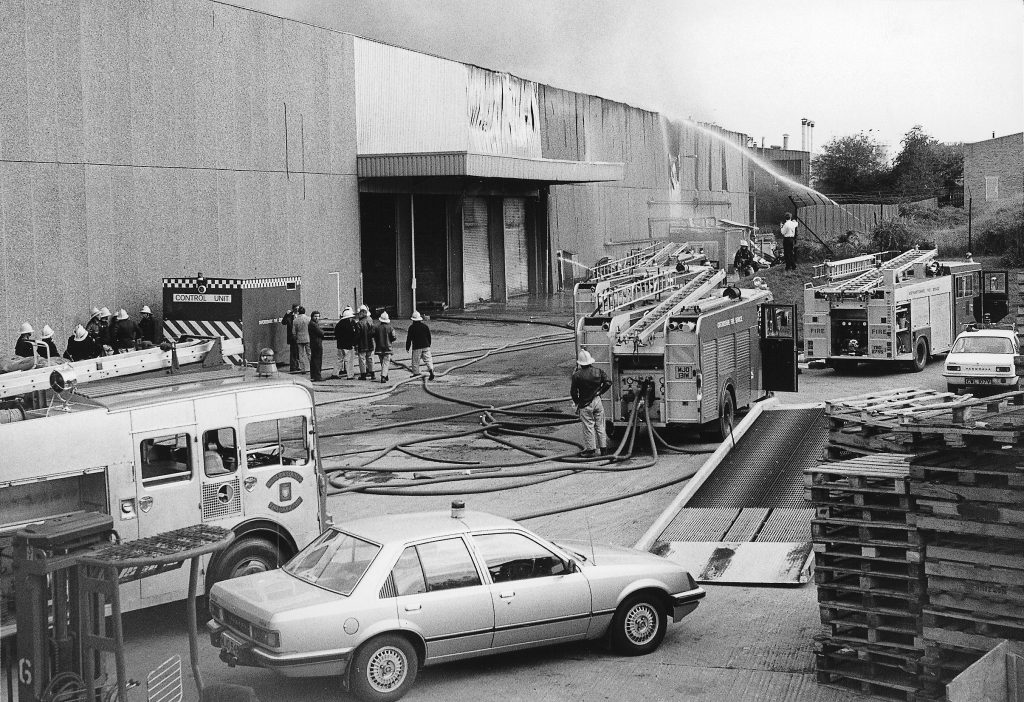
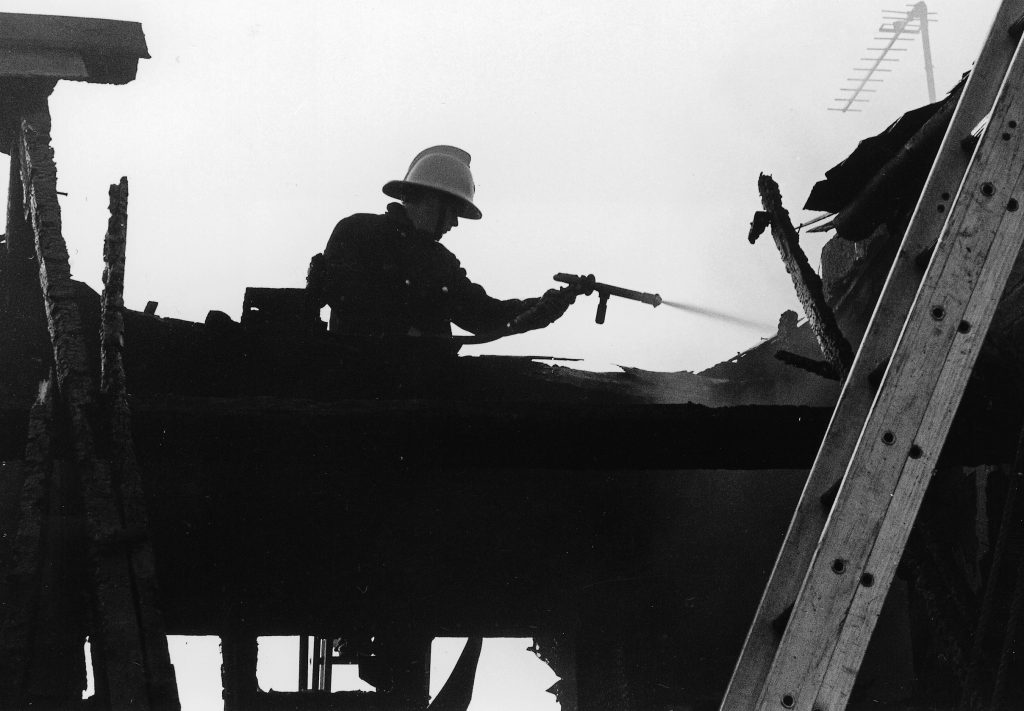
A significant event occurred during the year when the Brigade changed its title to Warwickshire Fire and Rescue Service.
